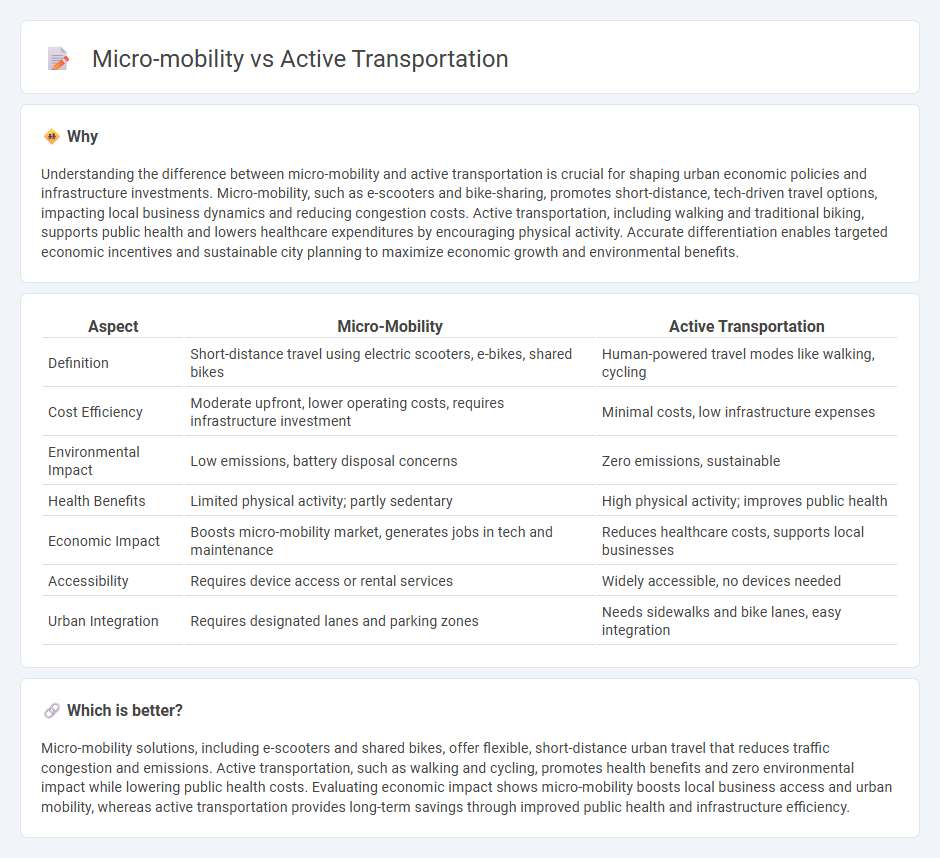
Micro-mobility solutions such as e-scooters and bike-sharing systems provide efficient, low-cost alternatives to traditional transportation, reducing urban congestion and carbon emissions. Active transportation, including walking and cycling, promotes health benefits and sustainable urban development while lowering infrastructure strain. Explore how these modes impact modern economies and urban planning for a cleaner, more connected future.
Why it is important
Understanding the difference between micro-mobility and active transportation is crucial for shaping urban economic policies and infrastructure investments. Micro-mobility, such as e-scooters and bike-sharing, promotes short-distance, tech-driven travel options, impacting local business dynamics and reducing congestion costs. Active transportation, including walking and traditional biking, supports public health and lowers healthcare expenditures by encouraging physical activity. Accurate differentiation enables targeted economic incentives and sustainable city planning to maximize economic growth and environmental benefits.
Comparison Table
| Aspect | Micro-Mobility | Active Transportation |
|---|---|---|
| Definition | Short-distance travel using electric scooters, e-bikes, shared bikes | Human-powered travel modes like walking, cycling |
| Cost Efficiency | Moderate upfront, lower operating costs, requires infrastructure investment | Minimal costs, low infrastructure expenses |
| Environmental Impact | Low emissions, battery disposal concerns | Zero emissions, sustainable |
| Health Benefits | Limited physical activity; partly sedentary | High physical activity; improves public health |
| Economic Impact | Boosts micro-mobility market, generates jobs in tech and maintenance | Reduces healthcare costs, supports local businesses |
| Accessibility | Requires device access or rental services | Widely accessible, no devices needed |
| Urban Integration | Requires designated lanes and parking zones | Needs sidewalks and bike lanes, easy integration |
Which is better?
Micro-mobility solutions, including e-scooters and shared bikes, offer flexible, short-distance urban travel that reduces traffic congestion and emissions. Active transportation, such as walking and cycling, promotes health benefits and zero environmental impact while lowering public health costs. Evaluating economic impact shows micro-mobility boosts local business access and urban mobility, whereas active transportation provides long-term savings through improved public health and infrastructure efficiency.
Connection
Micro-mobility solutions such as e-scooters and bike-sharing systems complement active transportation modes like walking and cycling by reducing reliance on personal vehicles and promoting sustainable urban mobility. Integrating these transportation methods helps decrease traffic congestion, lower carbon emissions, and stimulate local economies through increased accessibility and reduced transportation costs. Economic studies show that investments in micro-mobility infrastructure yield significant returns by supporting healthier lifestyles and enhancing workforce productivity.
Key Terms
Infrastructure Investment
Investment in active transportation infrastructure prioritizes pedestrian walkways, cycling lanes, and safe crossings to promote walking and biking as sustainable transport modes. Micro-mobility infrastructure includes dedicated parking, charging stations, and lane adaptations for e-scooters, e-bikes, and other small electric vehicles, emphasizing last-mile connectivity. Explore the latest trends and funding strategies in active transportation and micro-mobility infrastructure.
Operating Costs
Active transportation, such as walking and cycling, generally incurs minimal operating costs due to the lack of fuel requirements and low maintenance expenses for bicycles. Micro-mobility options like e-scooters and shared electric bikes have higher operating costs driven by battery charging, regular maintenance, and fleet management services. Explore more to understand the cost dynamics and sustainability benefits of each mode.
Urban Congestion
Active transportation, such as walking and cycling, significantly reduces urban congestion by decreasing reliance on motor vehicles and promoting sustainable city spaces. Micro-mobility options, including e-scooters and shared bikes, complement active transportation by offering flexible, first- and last-mile solutions that reduce traffic density and parking demand. Explore detailed studies and data on how these modes reshape urban mobility and alleviate congestion in growing metropolitan areas.
Source and External Links
Active mobility - Wikipedia - Active transportation is human-powered, non-motorized transport such as walking, cycling, running, skateboarding, and roller skating, promoting health and reducing fossil fuel use and emissions through policies that increase levels of active commuting.
Partnership for Active Transportation - Rails to Trails Conservancy - Active transportation, primarily walking and bicycling, fosters healthier communities by integrating physical activity into daily routines, improving economic and environmental well-being at a lower cost than roads.
Active Transportation | US Department of Transportation - The US DOT supports connected active transportation networks like bike lanes and sidewalks to create safe, affordable travel options, aiming to increase transit and active mode trips by 50% from 2020 and drive community cohesion and economic prosperity.
 dowidth.com
dowidth.com